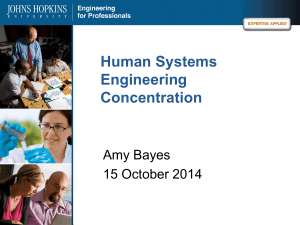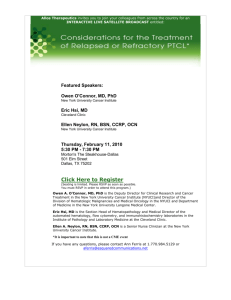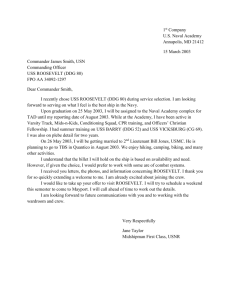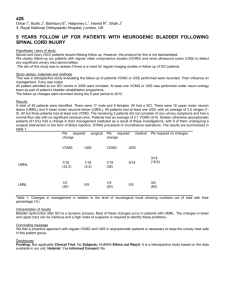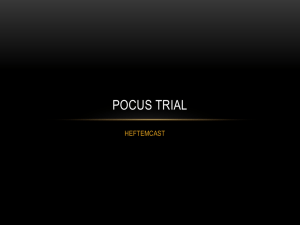Rethinking HSI: Human Systems and Technology: Divergent Growth
advertisement
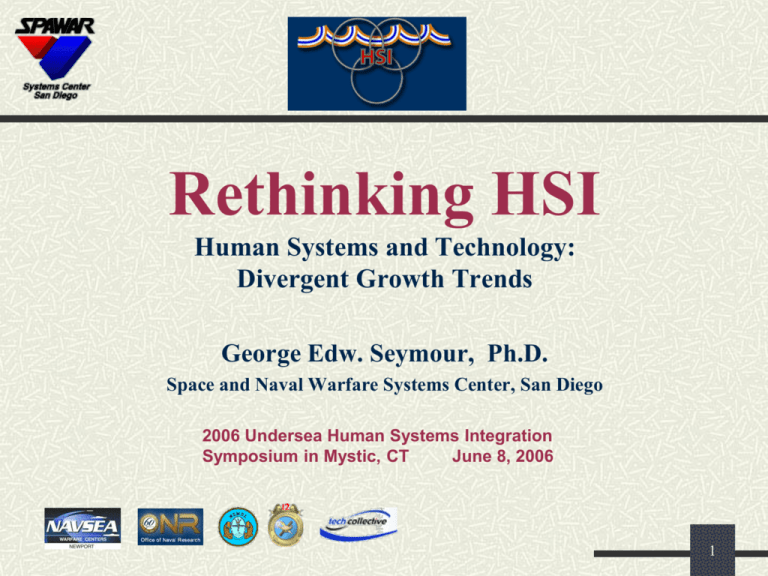
Rethinking HSI Human Systems and Technology: Divergent Growth Trends George Edw. Seymour, Ph.D. Space and Naval Warfare Systems Center, San Diego 2006 Undersea Human Systems Integration Symposium in Mystic, CT June 8, 2006 1 The Stage “In the final analysis, the performance of our nation's sailors makes the difference between victory and defeat.” Vice Admiral Phillip M. Balisle, USN (Ret) “Although we ‘steer by the stars and not our wake,’ tradition occasionally prompts us to revisit our heritage and remember those who stood the watch before we came aboard.” Today, here, now, tradition calls us again. 2 The Theme Humans and their tools have always represented functional capabilities. However, humans have not advanced anywhere near as rapidly as the technology they use, and that gap has major HSI implications as we speed along the technology highways. 3 The Message HSI is unquestionably essential to the Navy HSI has made significant advances in the recent decade, especially within the acquisition arena However, HSI as identified and practiced today is insufficient to move us forward into the knowledge and technology-base decades ahead HSI requires a comprehensive zero-based review Sub-message: We tend to address HSI as it was needed decades and centuries ago. But our emphasis is misguided <smile>. So what is HSI? / Why was it needed? / How did it evolve? / How are we doing? / What are we missing? 4 The Hypothesis Humans Technology + + % 0 Change % 0 Change - - Computer memory 1946 2006 1946 + 2006 + % 0 Change % 0 Change - Average Brain size Speed of a nerve impulse Calculations/Sec 1946 2006 - Reasoning Powers Visual/Auditory acuity 1946 2006 5 The Agenda Human Issues at Sea / Navy Mishaps / Human Error What is HSI? Why was it needed? How are we doing? A Glance Back: Safety, Medical, Habitability, Training… Two Diverse Themes The Olympics: Then and Now Human versus Technology Changes Over Time First HSI OIF Lessons Learned Study Who is this Guy? The Future: Technology, Education, & the Mind Worthy Authors HSI Must Mind the Gaps 6 Human Issues @ Sea USS Bennington ― 1954 (103) USS Thresher ― 1963 (129) USS Oriskany ― 1966 (44) USS Forrestal ― 1967 (134) USS Liberty ― 1967 (34) USS Scorpion ― 1968 (99) USS Enterprise ― 1969 (28) 7 Human Error: USN, USMC FY97-02 No. of Class-A Mishaps Navy/Marine Aviation* 138 of 170 Human Error HE 81% NonHE 19% *FY97-01 Navy Afloat 41 of 50 HE 82% Navy Operational Shore 36 of 48 HE 75% Navy PMV 295 of 350 HE 84% FY02: 27 March NonHE 18% NonHE 25% NonHE 16% 8 Naval Mishap Rates MAGNITUDE OF ACCIDENTS FY05 mishaps resulted in: • 1 Navy death every 88 hours (3.7 days) • 1 Marine Corps death every 78 hours (3.3 days) • 1 POV death every 83 hours (3.5 days) • 1 Aviation death every 9 days • 1 Active duty military injury every 6 hours • 1.8 Military members hospitalized every day • 11.33 Civilian man-years lost • 1 Aircraft destroyed every 20 days • $1.85 million (approx.) a day in aviation losses “While the overall Naval mishap rate has decreased slightly since FY04, the Material related mishap rate has remained relatively constant.” For FY05, preliminary results indicates a significant decrease in Human Error related mishaps. The primary contributor to the decrease in Human Error mishaps was a statistically significant decrease in mishaps that had Aircrew Errors. However, Aircrew continue to be cited as the primary contributing sources of the Human Errors in mishaps. 9 USN/USMC FY05 vs. FY04 Mishap Causal Factors Class-A Flight Mishaps Mishap Rate Per 100,000 Flight Hours 2.5 USN/USMC FY 04 USN/USMC FY 05 2 1.5 1 0.5 0 Mishap Rate Material Human Error Maintenance Facilities Supervisory Aircrew One example: 11 May 2005: A T-45 pilot inadvertently shut down engine while on final – pilot ejected safely. 10 Shore/Ground Operational Class-A Mishap Rates WHAT CAUSED SHORE/GROUND OPERATIONAL MISHAPS? • • • • • Human error - 95% Supervisory failure Poor training No use of ORM Lack of safety culture Mishap Rate Per 100,000 Personnel per Year Navy Marine 20.81 25 20 15.19 12.09 15 10 4.16 5 3.4 2.62 14.65 2.95 0 FY02 USN USMC 14 19 FY03 9 44 FY04 11 29 FY05 9 23 Number of Fatalities SHORE/GROUND OPERATIONAL MISHAPS AND FATALITIES 37 Mishaps: 11 Navy, 26 Marine 32 Deaths: 9 Sailors, 23 Marines 11 What is HSI & Why was it Needed 12 What affects Sailors 3 x 7 x 52? USS Constellation, 1897 Food Rations per week per Man according to Regulations of 1818: Salted beef was staple diet aboard ship. This tough cured beef, suitable only for long voyages when nothing else was as cheap or would keep as well, required prolonged chewing to make it edible. Men often chewed one chunk for hours, just as if it were chewing gum and referred to this practice as “chewing the fat.” Suet- 1/2 pound Cheese- 6 ounces Beef- 3 ½ pounds Pork- 3 pounds Flour- 1 pound Bread- 98 ounces Butter- 2 ounces Sugar- 7 ounces Tea- 4 ounces Peas- 1 pint Rice- 1 pint Molasses- 1/2 pint Vinegar- 1/2 pint Spirits- 3 ½ pints 6 ½ cents 6 ½ cents 29 cents 28 ½ cents 4 cents 30 ½ cents 3 cents 7 cents 12 cents 34 cents 5 cents 3 cents 2 cents 35 cents 13 When Something Hurts “Rheumatism, consumption, syphilis, debility and scurvy were the most frequent causes of medical discharges. Yellow fever and small pox were prevalent at certain seasons and in certain climates. Many officers continued service on shipboard during the last stages of consumption because of the lack of any sort of retirement benefits.” “No scurvy” until James Lind (British Navy) ~ 1750 “No bacteria” until Louis Pasteur ~ 1860 “Larger ships, such as frigates, had a surgeon and two or three surgeon's mates aboard while the very small vessels had none….On ships without a doctor the sick and wounded were cared for by the captain or a member of the crew. But in the early days of sailing, the cook was nicknamed "doctor" because at that time the cook was the only dispenser of medicine a ship carried.” Whiskey was used for pain, toothache, sprains, broken bones, ulcer, infections, etc. “A famous historian was once asked what historical era he would like to visit if possible. “Anytime after the invention of anesthesia," was his response.” 14 Habitability “Heating in the old sailing ships, many of which were in use until the late 1870s, was almost non-existent. The only fire allowed on board was the one in the galley on which the food was prepared. Wood or coal was used as fuel. The cabin and sick bay were heated by hot shot partially buried in sand in an iron bucket. The quarters of the enlisted men were unheated….With the advent of steam it became possible to heat our ships…. Enlisted personnel which included petty officers slept in canvas hammocks slung on the berth deck. When suspended, this canvas formed a receptacle for a mattress and blanket.” USS Kearsarge 1969 15 Human Factors & HFE Controls/Displays and Control Interface – “Dimly lit or glaringly bright displays and numerous colors on control panels can contribute to eye strain, head-aches, poor concentration, and confusion resulting in human error.” User Friendly Controls and Control Interfaces – “User-friendly controls, displays, and warning signals are essential to provide for rapid and accurate communication of information.” 16 Education & Training Middle Ages through the Industrial Revolution: Indenture, Apprentices (crafts and trades), Employees, Navy: Apprenticeship Schools OJT NKO Three Sea Warrior programs: Navy Knowledge Online (NKO), the 5 Vector Model (5VM) and the JASS Career Management System (JCMS). Issues: “Me and my parents correlate, because without them I wouldn't be here.” “I was meticulous about falling off the cliff.” “Mrs. Morrow stimulated the soup.” 17 Two Diverse Themes Theme One: Human Nature, the human mind and body, are exceptionally malleable, and can be molded and shaped by design or the environment. Theme Two: “Evolutionarily speaking we have little to evolve to physically. Those who study human evolution see little further physical evolution in our future. From here on out it will be cultural and yes, technological.” 18 The Olympic Games “The games originated in Greece near 2,800 years ago, and were then revived again in Athens in 1896. As a result, visitors to Greece can still see the original ancient stadium of ancient Olympia….One event at this year's games, the man and woman shot put, will actually be staged in the awe-inspiring setting, the difference from 2,700 years ago is that women will take part this time.” --Mayor of Athens, June 11, 2004 19 What’s Common? What’s Not? Greece 700 B.C. U.S.A. 2000 A.D. 20 Events Then (and Now) 1276 + BC: Contests but no winner recorded 776 BC: Coroebus of Elis, a cook, wins the stade (210 yds) 708 BC: Wrestling and the famous Pentathlon (the long jump, javelin throw, discus throw, foot race, and wrestling) were introduced. “The original events were even more challenging than those of today. The modern discus weighs in at just 5 pounds, one-third of the original weight, and the long jumps were done with the contestant carrying a five pound weight in each hand. The pit to be traversed in this jump allowed for a 50 foot jump, compared to just over 29 feet in our modern Olympics. Apparently, the carried weights, used correctly, could create momentum to carry the athlete further. Legend has it that one Olympian cleared the entire pit by approximately 5 feet, breaking both legs as he landed.” 21 The Four Minute Mile Once thought impossible; beyond human limits. May 6, 1954; Roger Bannister ran the first sub-four-minute mile in recorded history at 3 minutes 59.4 seconds. November, 2005, Forbes magazine declared after interviewing a number of sports experts that Bannister's four minute mile was "the greatest athletic achievement" of all time. Accurate times for the mile run (1.609 km) were not recorded until after 1850, when the first precisely measured running tracks were built. > $250 computerized shoes 1852: 4:28 > Personal training / health 1945: 4:01 > Compulsory education 1864: 4:20 1954: 3:59 > Technology: e.g. clocks 1911: 4:14 1965: 3:53 > Coaching, motivational hacks 1942: 4:04 1999: 3:43 > Vitamins, enzymes, proteins } 22 Communication: Nine Decades War in 2010: 1.5 trillion wpm Wideband Datalinks Gulf War: 192,000 wpm Networked Computers WW I: 30 wpm WW II: 60 wpm Vietnam: 100 wpm Field Phone Radio SATCOM We can transmit the entire Library of Congress each minute wpm = words per minute 23 Human vs. Technology Change Humans Over the course of 147 years, the time has decreased by 0.7478333 minutes (that is, nearly three-quarters of a minute, or about 44.87 seconds). Assuming a linear rate of change: * The time has decreased by about 16.7425% in 147 years; * The time has decreased by about 0.113895% per year; and * The time has decreased by 11.3895% per 100 years. Technology Over the course of 77 years, the number of words per minute (wpm) has increased by 191,970 per minute. Assuming a linear rate of change: * The wpm increased by about 640,000% in 77 years; * The wpm increased by about 8,311.6883% per year; and * The wpm increased by 831,168.83% per 100 years. 24 IQ Transitioning Few Science-Based Topics are as Contentious Interestingly, there are Three Views: Human IQ is (a) increasing, (b) relatively flat, or (c) decreasing “Neisser states that, "Whatever g may be, we at least know how to measure it….Raven Progressive Matrices….Arthur Jensen has said that Raven's test 'apparently measures g and little else‘….In The Netherlands, for example, all male 18-year-olds take a version of the Raven as part of a military induction requirement. The mean scores of those annual samples rose steadily between 1952 and 1982, gaining the equivalent of 21 IQ points in only 30 years! This amounts to a rate of no less than 7 points per decade -- a figure confirmed by data from many other countries.” The Flynn Effect: the continued year-on-year rise of IQ test scores in all parts of the world, but he favors an environmental explanation. 25 Transportation: Twenty-three Decades Ago “Before e-mail and global telephone capability, letters and packages were especially important to sailors at sea. Mail call was a time of connecting to family and friends that could not be accomplished any other way.” “The wooden sailing ships of the 18th century could deliver passengers and goods across great distances at speeds unimaginable on land, but the distances across the Atlantic Ocean were very great indeed: 5,000 miles from London to Boston, a trip that could take six to eight weeks —a seeming eternity in the dark, damp, cramped, and smelly quarters below deck on most sailing ships.” “In 1775, Benjamin Franklin completed the first scientific study of the Gulf Stream. His observations began in 1769 when as deputy postmaster of the British Colonies he found ships took two weeks longer to bring mail from England than was required in the opposite direction.” 26 First HSI OIF LL Initiative: 8/2003 OIF Platforms: Two of each kind (CV to SS) Inclusive vs. narrow HSI focus “Deckplate” focus (O-5 – E-3) versus unit commanders Tactical & Non-tactical network experience Scientifically based: Sampling error goal 5 % Two formats (pilot tested twice) Interview Self-administered form Minimize impact on both commands & platform personnel Resource limited (i.e., researchers and funding) 27 Visited 16 Commands on Both Coasts Carrier Air Wing Three Carrier Group Two USS Harry S. Truman (CVN-75) USS Kearsarge (LHD-3) USS Donald Cook (DDG-75) USS Montpelier (SSN 765) USS Iwo Jima (LHD-7) USS Mitscher (DDG-57) USS Boise (SSN-764) West Coast USS Shiloh (CG-67) VAW 116 USS Tarawa (LHA-1) VFA-137 USS Nimitz (CVN-68) USS Milius (DDG-69) USS Pearl Harbor (LSD-52) Conducted 60 OIF HSI-focused interviews which provided 484 comments Side 1 of survey form: Opportunity to choose from 19 HSI-related categories for discussion Collected nearly 2,000 HSI-focused forms: Side 1 – rate, pay grade, OIF and current tasks, SW/HW used, etc. Side 2 – 9 areas to provide comments, plus six-point satisfaction score 28 60 Half-hour Interviews Table 1: Interviewee Rank Enlisted N Officer N E-4 2 W-2 1 E-5 6 W-3 2 E-6 10 O-1 2 E-7 10 O-2 7 E-8 2 O-3 9 O-4 7 O-5 2 All 60 interviews were conducted with OIFexperienced personnel, having either tactical or non-tactical (or both) network experience. Interviews lasted about 40 minutes each, and provided a total of 484 anonymous comments in 19 categories. 29 Interview Topics Percentage of HSI Comments Education & Training Collaboration Human Factors Engineering Data & Info Distribution Focused Logistics Command and Control Battlespace Aw areness Category Manpow er Habitability Personnel Know ledge & Wisdom Medical Factors Miscellaneous Joint, Coalition & NGO Ops ISR Personnel Survivability Decision Speed & Superiority Health Hazards System Safety 0 5 10 15 20 25 Percentage of Com m ents 30 HSI Study Findings 6 5 500 4.5 400 4 3.5 300 3 200 2.5 Average Rating 5.5 600 2 100 1.5 Habitability Internet Health Hazards Manpower, Personnel & Training Human Factors Engineering Information & Knowledge Mgmt Medical 1 Safety 0 Personnel Survivability Number of Comments 700 HSI Category Number of Comments Received (Enlisted) Number of Comments Received (Officers) Average Rating (Scale 1 – 6) 31 Who is this guy? And why is he important to the future of the Department of Defense? 32 Johnathan Wendel aka Fatal1ty is a “cold-blooded killer” “He plays violent, firstperson-shooter video games better than anyone in the world.” “John, it's your choice," his father told him. "If you think you can do it, you can do it." They struck a deal: If he played well and won some cash, he could chase a pro gaming career. If he came home empty-handed, he would enroll in school full time.” 33 Technology Advances Rob and Linda Perrin plan their wedding. Later, they marry for $300 while sitting at home in Tennessee. “Linda stopped Rob from turning around to peek at her screen, to catch a glimpse of the bride preparing her entrance. The virtual bride and groom converse during the Perrins' virtual wedding, while in real life, the Perrins sit back to back in their home office in Cookeville, TN…. every sunset and rise, every kiss, dance step, and swing of a sword - is a vicarious pixel mesh. ” 34 “Human-Fusing” Technology 2002: > 700 COTS Collaboration Tools 2006: > 14 COTS Collaboration Technologies: Blogs, Bluetooth, Chat, IM, Pocketcasting, Podcasting, RFID, RSS, Videoconferencing, VoIP, VoiceXML, VPOs, Webcasts, Wikis. Facebook: “Facebook is a social directory that enables people to share information. Launched in February 2004, Facebook helps people better understand their world by giving them access to the information that is most relevant to them. Facebook's website has grown to over 7.5 million people and, according to comScore, ranks as the seventh-most trafficked site in the United States.” MySpace.com: purchased by Rupert Murdoch's News for over $500 million, is the virtual hangout for tens of millions of teenagers and twentysomethings. 35 The Looming Tech Challenges Michio Kaku, expects that in the next 100 years our cultural and especially our technological evolution will take us from a “Type 0” civilization to “Type 1” civilization. Type 3 – has control of the galaxy and all of its powers and understanding. Type 2 – has control of its star (e.g. the sun) and all of its powers and understanding Type 1 – has control over the planet and all of its resources, powers and understanding Type 0 – has control over nothing… 36 Has the Mental Requirement Changed? “The GCT was the General Classification Test used by the Navy for enlisted classification, as part of the Basic Test Battery (BTB) from 1942 onward. The GCT component consisted of 100 verbal analogies and sentence completion items….GCT + ARI were combined to form the "General Technical" composite and used to place applicants in higher technical skill area.” Today there “really is no corollary to the verbal analogies GCT test for enlisted personnel (too bad).” “About 65% take the computer adaptive version of the ASVAB, the rest is paper & pencil. At this point, there is no on-line/web-based version. But they are working on it.” 37 ASVAB: 1974 - Today Verbal Word Knowledge (WK) Ability to select the correct meaning of words presented in context and to identify best synonym for a given word. Paragraph Comprehension (PC) Ability to obtain information from written passages. Mathematics Arithmetic Reasoning (AR) Ability to solve arithmetic word problems. Mathematics Knowledge (MK) Knowledge of high school mathematics principles. Science/Technical General Science (GS) Knowledge of physical and biological sciences. Electronics Information (EI) Knowledge of electricity and electronics. Auto Information (AI) Knowledge of automobile terminology and technologies. Shop Information (SI) Knowledge of tools and shop terminology and practices. Mechanical Comprehension (MC) Knowledge of mechanical and physical principles. Assembling Objects (AO) Ability to figure out how an object will look when its parts are put together. What is missing? For example, is reasoning capacity best defined in terms of complex relations that can be processed in parallel? Should we assess for collective reasoning ability? 38 Learning “In ancient times, teaching and learning were accomplished through apprenticeship: We taught our children how to speak, grow crops, craft cabinets, or tailor clothes by showing them how and by helping them do it. Apprenticeship was the vehicle for transmitting the knowledge required for expert practice in fields from painting and sculpting to medicine and law. It was the natural way to learn. In modern times, apprenticeship has largely been replaced by formal schooling, except in children's learning of language, in some aspects of graduate education, and in on-the-job training. We propose an alternative model of instruction that is accessible within the framework of the typical American classroom. It is a model of instruction that goes back to apprenticeship but incorporates elements of schooling. We call this model "cognitive apprentice-ship."” (Collins, Brown, & Holum, 1991) 39 Steven Levitt, author of Freakonomics: “Stumbling on Happiness is an absolutely fantastic book that will shatter your most deeply held convictions about how your own mind works.” Daniel Kahneman, recipient of the 2002 Nobel Prize in Economics: “Everyone will enjoy reading this book, and some of us will wish we could have written it. You will rarely have a chance to learn so much about so important a topic while having so much fun.” Daniel Gilbert, Harvard psychology professor, is a pioneer in the research of affective forecasting 40 A New Learning “Mesulam, who was among the first scientists to predict the existence of convergence zones within interconnected brain networks, said the study presents "the clearest and most convincing evidence to date" of the dynamics in effective connectivity. To better understand dynamic effective connectivity, Mesulam compares the brain networks to a network of highways connecting different parts of a city. The highway is static. No matter how heavy the traffic load, it always has the same number of lanes. In the brain, there is a dynamic change that allows certain pathways to preferentially facilitate the demands of a given cognitive task. The brain highway in effect "adds lanes" to accommodate the requirements of the particular task.” (Northwestern University, 2005) 41 Social Networks & Production “Yochai Benkler’s book, The Wealth of Networks, is out. This is — by far — the most important and powerful book written in the fields that matter most to me in the last ten years. If there is one book you read this year, it should be this. The book has a wiki; it can be downloaded as a pdf for free under a Creative Commons license….” Professor Lessig, 2006 Stanford Law School 42 The New HSI Challenge “Each one of us has been entrusted with the care and nourishment of what might be the most extraordinary and complex creation in the universe. Home to mind and personality, the human brain archives cherished memories and hopes for the future. It arranges and coordinates the elements of consciousness that gives us purpose, passion, motion, and emotion. But the brain is too fragile. It is far too vulnerable to be allowed to continue in its current state. In order to properly sustain the brain, we need to know what it likes, the challenges it craves, the rest it requires, and the protection it deserves. In short, the brain must have a strategy for its future.” (Vita-More, 2006) 43 A Multi-HSI Approach Quantifying Human Information Processing Edited by Dennis K. McBride & Dylan Schmorrow “Rapid advances in IT that allow complex information to be presented in high volume and density are challenging human ability to absorb and analyze data as never before….But to do this, quantitative relationships between brain behavior at a molecular level and observable human behavior must be better identified. This was previously considered to be a futuristic, and somewhat unrealistic, goal, however, recent advances in cognitive neuroscience have provided new opportunities for researchers.” “This book starts to answer the question of how to maximize information processing without overloading the central nervous system. This volume is a valuable contribution to the fields of psychology, neuroscience, and cognition and will serve as a resource for human-factors engineering designing the next generation of information, safety, analysis, and control systems.” 44 HSI Must Mind the Gaps Yes, it’s a play on words, HSI Tomorrow is ill defined, but visible, We, here, today are responsible for HSI tomorrow, What we need is a small team to construct an initial scaffolding of an analytical HSI framework capable of increasing our understanding of the historical evolution of HSI topics that will forge a rudimentary guide to DoD policy in the ongoing task of improving sailor/warrior performance. 45 Hyperlinked Resources A Gift of Peace from the Past, the Ancient Olympics: http://tinyurl.com/z946h Abbott, J. (2004). Lieutenant Peter Puget, the Grain of the Brain and Modern Society’s Failure to Understand Adolescents: http://www.21learn.org/arch/articles/peter_puget.html Collins, A. Brown, J.S. & Holum, A. (1991). Cognitive Apprenticeship: Making Thinking Visible. http://www.21learn.org/arch/articles/brown_seely.html Nautical Nonfiction Adventure Booklist: http://euler.sfasu.edu/booklists/nautnonf.html Seymour, G. E. (2003). Human Error: Pervasive and Perennial. Presented at the 9th Human Factors and Ergonomics Society, San Diego Chapter Symposium, March 8. Seymour, G. E. (2004). The Unites States Navy: Then & Now: http://www.linking.to/Navy/ Seymour, G. E. & Van Horn, S. (2004). HSI Lessons Learned Status Report: FORCEnet HSI Working Group. http://www.linking.to/HSI/HSI_LL_Brief.html Steber, D. (2006). Navy Assists National Geographic on Forrestal Special: Military.com: http://www.military.com/features/0,15240,94668,00.html?ESRC=navy.nl Systems Thinking: http://www.umsl.edu/~sauter/analysis/bees/ University Of Chicago Researchers Discovered That Humans Are A 'Privileged' Evolutionary Lineage: http://www.sciencedaily.com/releases/2005/01/050111170714.htm Vita-More, N. (2006). Strategic Sustainable Brain: http://www.kurzweilai.net/meme/frame.html?main=/articles/art0662.html Wall, J., Elms, R., Biggers, K. & Sticha, P. (2004). Knowledge Networks for Future Force Training: Illustration of Searching, Retrieval, and Communication Concepts. Research U.S. Army Report 1823: http://www.hqda.army.mil/ari/wordfiles/RR%201823.doc Wiedemann, O. W. (1902). How Uncle Sam Trains His Apprentice Boys. U.S. Navy Apprentice Boys. http://navalapprentice.white-navy.com/index.shtml 46 Backup Slides & Contact Information 619-553-8008 George.Seymour@Navy.mil George.Edw@Gmail.com 47 HSI Study Sampling Guide First Column is the population size, and the second and third columns identify the sample sizes required for 5 and 7 percent precision. Reasonably, the greater the population and the greater the precision required, the larger the sample necessary. At a population of 2,000, the sample required for 3 percent is 714; all below 2,000 requires full sampling. Note that sample size percent of change diminishes rapidly as the population size increases, and that it asymptotes at approximately 400 and 200 respectively for 5 & 7 %. 100 150 200 250 300 350 400 450 500 1000 2000 3000 4000 5000 10,000 25,000 50,000 100,000 81 110 134 154 172 187 201 212 222 286 333 353 364 370 385 394 397 398 67 86 101 112 121 129 135 140 145 169 185 191 194 196 200 204 204 204 48 Historically Forester: Horatio Hornblower Series Dana: Two Years Before the Mast O'Brian: Master and Commander Winslow Homer Homer (1887) Eight Bells “Give the men a ration of grog.” 49 Transportation From the time of the Greeks to the beginning of the 19th century transportation was no faster than the speed of a horse. Travel time to Europe by sea lasted about 30 days, with luck. Travel time to Pacific coast reduced from six months to 90 days by clipper ships in 1850s. 1650-1800 Easier to send products to Europe than to other American colonies. All market crops were within 10 miles of water. 50
